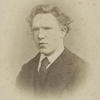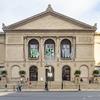More about Grapes, Lemons, Pears, and Apples

Contributor
The most immediately unique thing in Grapes, Lemons, Pears, and Apples, from Vincent van Gogh's short residence in Paris, is its psychedelic lines which undulate around what otherwise appears to be a garden-variety still life arrangement.
Many decades later, this kind of border distortion would become popular in movies and television as a scene transition, but when van Gogh did it, few people besides his brother and close friends could really dig it. This work dates from just before van Gogh skipped town for Arles, and it reflects the pressure van Gogh felt, and often described in his letters from the big city. Just before leaving Paris, van Gogh wrote to Theo, "at times it seems to me that my blood is more or less ready to start circulating again, which wasn't the case lately in Paris."
According to the Art Institute of Chicago, van Gogh's friend, fellow artist, and, for a brief time, the owner of this painting, Émile Bernard, called it a "violent still life." The violence may not even be solely in the image of the fruit itself, but also in the sad story of van Gogh. The same year, van Gogh wrote to his sister, Willemien, that his own "adventures are restricted chiefly to growing into a little old man...with a number of false teeth...but what does it matter? I have a dirty and hard profession—painting." He saw himself as a martyr on the altar of sentiment, the conscience by which, he wrote from Paris, "true painters" are guided.
Van Gogh loved the bodies depicted in Eugene Delacroix, but he didn't have the dough to hire models, so he found himself painting still lifes and self-portraits day after day in his apartment. The Art Institute of Chicago, which maintains this work, suggests that it was part of van Gogh's winter exhibition at Grand-Bouillon Restaurant du Chalet in Montmartre, which was organized in an effort to build camaraderie among young eccentric artists. Van Gogh compared the huge venue to a "Methodist chapel," and Bernard noted that the regulars ate their meals uneasily, disturbed by "the repellent appearance of the painters and the paintings." Paul Gauguin showed up and traded two van Gogh works for one of his, a backhanded way of throwing shade if ever there was one. Van Gogh sold only two paintings.
Sources
- Bailey, Martin. The Sunflowers Are Mine: The Story of Van Gogh's Masterpiece. London: White Lion, 2019.
- Charles, Victoria. Vincent van Gogh. New York: Parkstone International, 2012.
- "Grapes, Lemons, Pears, and Apples." Art Institute Chicago, https://www.artic.edu/artworks/64957/grapes-lemons-pears-and-apples.
- Groom, Gloria Lynn. Van Gogh's Bedrooms. New Haven: Yale University Press, 2016.
- Leaf, Alexandra. Van Gogh's Table: At the Auberge Ravoux. New York: Artisan, 2006.
- de Leeuw, Ronald. The Letters of Vincent Van Gogh. London: Penguin UK, 2003.
- Murphy, Bernadette. Van Gogh's Ear. New York: Farrar, Straus and Giroux, 2016.











